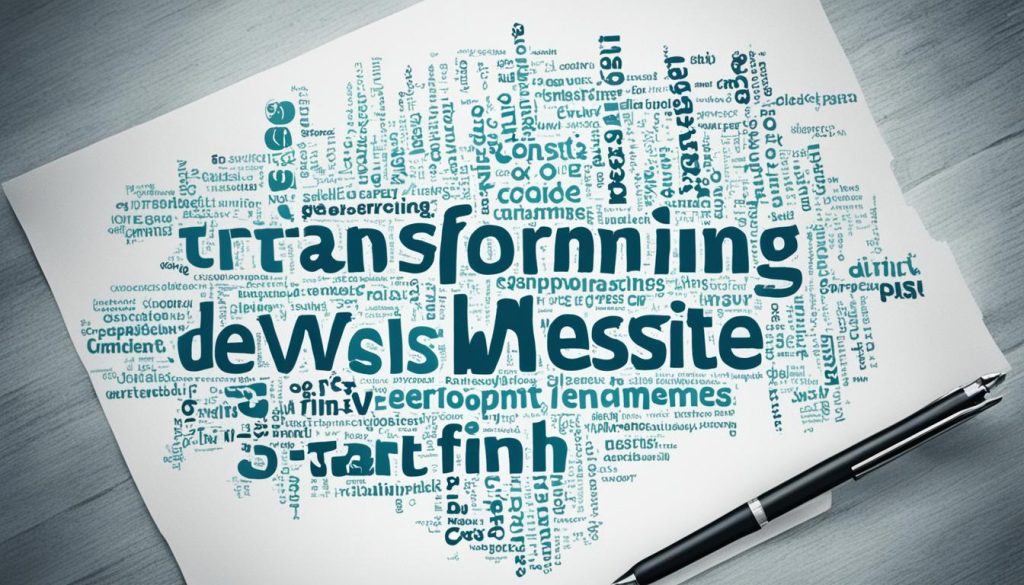Welcome to our step-by-step guide on how to create your own website. Whether you’re a business owner or looking to build your personal brand, this guide will help you in your journey to build your own website. Creating a website may seem challenging, but with the right tools and guidance, you’ll be able to create a professional and visually appealing website that meets your needs and goals.
Throughout this guide, we’ll provide you with valuable insights and tips on how to make a website. From designing the layout to selecting the right colors and fonts, from learning the basics of web development to starting your website from scratch, we’ll cover all the essential steps to ensure your success. Don’t worry if you have no coding experience – we’ll break it down into simple and easy-to-understand steps.
In addition, we’ll guide you through the process of choosing a domain name, selecting a hosting provider, and even show you how to create a website for free using popular platforms. Whether you’re looking to create a website for your business or your personal brand, we have a section tailored just for you.
Ready to take the next step in building your online presence? Let’s get started and learn how to make a website!
How to Make a Website?
Creating a visually appealing website requires careful consideration of essential design elements. From choosing the right layout to selecting appealing colors and fonts, every decision contributes to the overall user experience. In this section, we will explore the key aspects of website design and provide valuable tips for building a visually stunning website.
Selecting the Right Layout
The layout of a website plays a crucial role in its overall design. Whether you opt for a simple and intuitive grid-based layout or a more creative and dynamic design, it is important to consider the user’s journey and prioritize ease of navigation. A well-structured layout ensures that visitors can find the information they need quickly and effortlessly.
Choosing Colors and Fonts
The choice of colors and fonts greatly impacts the overall look and feel of a website. Select a color palette that aligns with your brand identity and evokes the desired emotions. Consider the psychology of colors and how they can influence user perception. Similarly, choose fonts that are legible and contribute to the overall aesthetics of your website. Experiment with font pairings to create visual harmony.
Creating Engaging Visuals
Visuals, such as images, illustrations, and videos, are powerful tools for capturing users’ attention and conveying your message effectively. Use high-quality visuals that are relevant to your content and resonate with your target audience. Optimize image sizes to ensure fast loading times and consider using alt tags to improve accessibility and search engine optimization.
Emphasizing User-Friendly Navigation
Smooth navigation is essential for an intuitive user experience. Incorporate clear and easy-to-use navigation menus, ensuring that visitors can effortlessly explore different sections of your website. Consider implementing a breadcrumb trail or a sitemap to help users understand their current location within your website and easily navigate back to previous pages.
Designing for Mobile Responsiveness
In today’s mobile-centric world, it is imperative to design websites that are responsive across different devices. Optimize your website for mobile viewing by ensuring that it adapts seamlessly to various screen sizes. Test your website on different devices to ensure that all elements are displayed properly and that the user experience remains consistent.
Ensuring Readability and Accessibility
Text content should be easy to read and accessible to all users. Use an appropriate font size and pay attention to the contrast between the text and background. Ensure that your website is accessible for users with visual impairments by implementing alt tags for images, providing descriptive captions for videos, and using descriptive headings to structure your content.
Optimizing Page Load Speed
Page load speed is crucial for providing a seamless browsing experience. Optimize your website’s performance by minimizing file sizes, leveraging browser caching, and reducing the number of HTTP requests. Regularly monitor and analyze your website’s speed using tools such as Google PageSpeed Insights to identify areas for improvement.

| Element | Tips |
|---|---|
| Layout | Choose a layout that enhances user navigation and content visibility. |
| Colors and Fonts | Select a visually appealing color palette and fonts that complement your brand. |
| Visuals | Incorporate high-quality images and videos that enhance the user experience. |
| Navigation | Create intuitive and user-friendly navigation menus. |
| Mobile Responsiveness | Design your website to ensure a seamless experience across different devices. |
| Readability and Accessibility | Optimize text content for readability and make your website accessible to all users. |
| Page Load Speed | Optimize your website’s performance for faster page load times. |
Web Development Tutorial
Welcome to the web development tutorial section. In this tutorial, we will provide you with a step-by-step guide on how to make a website from scratch using HTML. Even if you have no coding experience, don’t worry! We will break down the process into easy-to-understand steps, allowing you to create your own website with confidence.
HTML Basics
Before we dive into building a website, let’s start with the basics of HTML. HTML, or Hypertext Markup Language, is the standard language for creating web pages. It provides structure and format to the content on a website. With a few simple elements, you can create headings, paragraphs, lists, and more.
Building a Website from Scratch
Now that you understand the basics, it’s time to start building your website. Here are the steps you’ll follow:
- Create a new HTML file: Begin by opening a text editor and creating a new file with the extension “.html”.
- Set up the document structure: Every HTML document needs a proper structure. Start with the doctype declaration and the opening and closing
<html>tags. - Add a head section: The head section contains metadata about the document, such as the title and references to external stylesheets or scripts.
- Build the body: The body section is where you add the content that will be displayed on your webpage. Use HTML tags to structure and format the content.
- Save and view your webpage: Save the HTML file and open it in a web browser to see how your website looks.
By following these steps, you will be able to create a basic website using HTML. As you progress, you can explore more advanced HTML elements and CSS to enhance the design and functionality of your website.

Now that you have a better understanding of web development and HTML, you are ready to start building your own website from scratch. Don’t let the initial complexity intimidate you – with practice, you’ll become more comfortable with web development and unlock endless possibilities for creating stunning websites.
Starting a Website Tutorial
If you’re ready to start your own website, you’ve come to the right place. In this section, we will guide you through the process step-by-step, from selecting a domain name to choosing a hosting provider. Whether you want to create a personal blog or a business website, we’ll cover all the essential steps to get you up and running.
Choosing a Domain Name
The first step in starting a website is choosing a domain name. Your domain name is your website’s address on the internet, so it’s important to choose a name that is memorable and reflects your brand or purpose. Here are some tips:
- Keep it simple and easy to spell
- Avoid using numbers or hyphens
- Try to include relevant keywords
- Consider using your brand or business name
Once you’ve decided on a domain name, you’ll need to register it with a domain registrar.
Selecting a Hosting Provider
After choosing a domain name, the next step is to select a hosting provider. A hosting provider is a company that stores your website files and makes them accessible on the internet. Consider these factors when choosing a hosting provider:
- Reliability and uptime
- Storage and bandwidth
- Customer support
- Security measures
There are different types of hosting options available, such as shared hosting, VPS hosting, and dedicated hosting. Choose the one that best suits your needs and budget.
Creating a Website for Free with Google Sites
If you’re looking to create a website for free, you can use Google Sites. Google Sites is a user-friendly platform that allows you to build and host websites without any coding knowledge. Here’s how to get started:
- Sign in to your Google account
- Go to Google Sites
- Click on the “+” button to create a new site
- Select a template or start from scratch
- Add content, images, and customize the design
- Preview your site and publish it
With Google Sites, you can easily create a basic website or even a simple online store without spending a penny.

Now that you have a domain name and hosting provider, or have created a website for free using Google Sites, you’re well on your way to launching your website. In the next section, we’ll focus on creating a website specifically for business purposes.
Creating a Website for Business
Are you looking to establish a strong online presence for your business? In this section, we will guide you through the process of creating a professional website that effectively represents your brand and attracts customers. Whether you are a small business owner or an entrepreneur starting out, these valuable insights and tips will help you build a website that stands out from the competition.
Showcasing Your Products or Services
One of the key objectives of your business website is to showcase your products or services. You can use visually appealing images, detailed descriptions, and customer testimonials to convey the value you offer. Highlight the unique features and benefits that set your offerings apart from competitors. By providing comprehensive information, you can inspire confidence and ignite interest in potential customers.
Optimizing for Search Engines
Optimizing your website for search engines is crucial to ensure that potential customers can find you online. Conduct thorough keyword research to identify relevant and high-ranking keywords related to your business. Optimize your website’s meta tags, headings, and content with these keywords to improve your search engine rankings. Additionally, create valuable and informative content through blog posts or articles to attract organic traffic to your website.
Attracting Customers to Your Business
Once your website is live, it’s essential to attract customers and drive traffic to your business. Promote your website through various channels such as social media platforms, email newsletters, and online advertising. Collaborate with influencers or industry partners to increase brand visibility. Additionally, consider implementing lead generation strategies such as offering exclusive discounts or downloadable resources to incentivize visitors to provide their contact information.
Creating a website for your business doesn’t have to be complicated or expensive. By following these steps and utilizing the available resources, you can create a professional website that effectively represents your brand and attracts customers. Now is the time to establish your online presence and grow your business in the digital world.

| Advantages of Creating a Website for Your Business | Disadvantages of Not Having a Website for Your Business |
|---|---|
|
|
Building a Website for Your Brand or Small Business
In today’s digital age, having a website for your brand or small business is essential for success. It is a powerful tool that allows you to establish an online presence, connect with customers, and showcase your products or services. In this section, we will explore steps on how to make a website that represents your brand effectively and helps you generate income.
Choosing the Right Website Builder
When embarking on the journey of building a website, one of the first decisions you will need to make is choosing the right website builder. These platforms provide intuitive drag-and-drop interfaces that make the process easier, even for those without technical expertise. Popular website builders like Wix, Squarespace, and WordPress allow you to create a professional-looking website without the need for coding.
Consider the features, pricing plans, and templates offered by different website builders to determine which one best suits your needs. Look for customization options, reliable customer support, and seamless integrations with essential tools and plugins. Remember, the website builder you choose will shape the foundation of your online presence, so it’s crucial to make an informed decision.
Designing a Captivating Website
A visually appealing website immediately captivates visitors and leaves a lasting impression. The design of your website should reflect your brand identity and resonate with your target audience. Here are some tips to create an engaging website:
- Choose a clean and modern design with a user-friendly interface
- Optimize your website for mobile devices, as more people access the internet through smartphones
- Use high-quality images and videos to enhance visual appeal
- Ensure clear and easy navigation for a seamless user experience
- Consider incorporating interactive elements to increase user engagement
Remember, your website is often the first point of contact for potential customers. Make it visually appealing and easy to navigate, leaving them with a positive impression of your brand.
Monetizing Your Website
A website has the potential to be more than just an online presence; it can also be a source of income for your brand or small business. Here are some strategies you can implement to monetize your website:
- Displaying relevant and unobtrusive advertisements
- Creating and selling digital products or online courses
- Offering premium content or membership subscriptions
- Participating in affiliate marketing programs
- Providing sponsored content or sponsored posts
Consider your target audience and the nature of your brand or business when implementing monetization strategies. Ensure that your website’s content and monetization methods align with your brand values and provide value to your visitors.
Key Takeaways
Building a website for your brand or small business is an important step towards establishing an online presence and reaching a wider audience. By choosing the right website builder, designing an engaging website, and implementing effective monetization strategies, you can create a website that not only represents your brand effectively but also generates income for your business. Take the time to understand your target audience, invest in quality design, and leverage the power of the digital landscape to make your website a valuable asset for your brand or business.
Conclusion
In conclusion, creating a website may seem daunting, but with the right guidance and tools, it can be a rewarding experience. By following our step-by-step guide, you can confidently embark on the journey of making your own website. Remember, Rome wasn’t built in a day, and building a website takes time and effort. But fear not, we have provided you with all the resources and tips you need to succeed.
Utilize the insights shared in the previous sections on website design, web development, and starting a website. Take advantage of the tutorials and guides we’ve curated to simplify the process for you. Stay focused and committed to your goals, and you’ll be well on your way to creating a website that suits your specific needs and objectives.
Now is the time to start building your online presence. Whether you’re a business owner or an individual looking to establish your personal brand, a website is a powerful tool to showcase your products, services, or talents. Embrace the opportunity to connect with your target audience and tap into a global market.
So, what are you waiting for? Take the first step today and begin your website-building journey. With determination, perseverance, and our comprehensive guide, you have everything you need to make a website that stands out in the digital landscape. Good luck and happy website building!
FAQs
Is it possible to make a website without coding?
Yes, it is possible to make a website without coding knowledge. Website builders like Wix, Squarespace, and Weebly offer intuitive drag-and-drop interfaces that allow you to create a website without writing any code. These platforms provide pre-designed templates and easy customization options.
Can I make a website using HTML?
Yes, you can make a website using HTML. HTML (Hypertext Markup Language) is a standard language for creating webpages. By learning HTML tags and syntax, you can build a website from scratch using a text editor and a web browser. However, using a website builder or content management system (CMS) may be easier for beginners.
What are some important factors to consider when designing a website?
When designing a website, consider the following factors:
- Choose a visually appealing and user-friendly layout.
- Select colors and fonts that reflect your brand or theme.
- Create clear navigation menus for easy website navigation.
- Ensure your website is optimized for different devices (desktop, mobile, tablet).
- Include relevant and engaging content.
- Use high-quality images and videos.
How can I optimize my website for search engines?
To optimize your website for search engines:
- Research and use relevant keywords throughout your website’s content.
- Write unique and descriptive meta tags for each page.
- Create a clear and descriptive URL structure.
- Optimize your website’s loading speed.
- Ensure your website is mobile-friendly.
- Build high-quality backlinks to your website.
How can I attract customers to my business website?
To attract customers to your business website:
- Use social media to promote your website and engage with potential customers.
- Implement SEO strategies to increase your website’s visibility in search engine results.
- Create valuable and relevant content that attracts your target audience.
- Offer special promotions or incentives for website visitors.
- Collect and utilize customer reviews and testimonials.
- Utilize email marketing to reach out to your audience.

